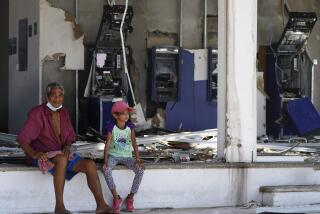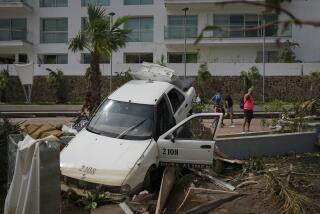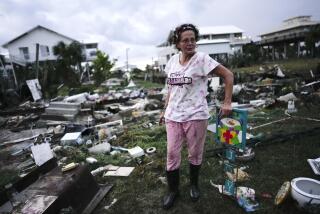Struggling back -- again
Weather-whipped Floridians blinked into the bright sun Monday and for the fourth time in six weeks trudged toward recovery, dragging broken tree limbs and ripped shingles to the curb.
President Bush late Monday asked Congress for $7.1 billion to help recovery efforts in Florida, other states and the Caribbean after hurricanes Ivan and Jeanne. The request makes a total of $12.2 billion in federal disaster aid requested by the administration for the four hurricanes that have hit Florida.
Three million people statewide still had no electricity, and hundreds of thousands face the prospect of waiting weeks to get it back because of Hurricane Jeanne’s weekend rampage.
Progress Energy made an unusual emergency decision to fly in repair crews. Crews will travel on commercial and corporate planes, and their equipment trucks will be brought in on flatbed trailers or leased.
Utility workers across the state are running out of steam.
“It’s an endurance test for us and our customers. Hopefully, there won’t be another leg to this,” said Grant Heston, a spokesman for Orlando Utilities Commission.
The state death toll remained at six Monday, but as search and recovery efforts get into full swing it could easily climb, officials said. The hurricane made landfall about midnight Saturday at Hutchinson Island on Florida’s east coast and slowly cut a northwesterly swath up near Tampa Bay.
Insured losses from Hurricane Jeanne could range from $6 billion to $8 billion, according to an estimate released Monday by Eqecat Inc., a hurricane-loss modeler.
Public schools in Orange, Brevard, Lake, Osceola and Polk remain closed today because of power outages. Seminole and Volusia county school districts are the only ones in the region that plan to hold classes this morning.
After further deluging the flooded St. Johns River and its tributaries in Volusia and Seminole counties, Hurricane Jeanne was downgraded to a tropical storm as it spun north into Georgia on Monday. It was expected to further weaken into a tropical depression as it moves into the Carolinas today.
Meanwhile, Tropical Storm Lisa weakened Monday as it inched north in the open Atlantic, no threat to the United States.
Jeanne hit Florida as a Category 3 with 120-mph winds -- tearing up beaches, homes and hotels, as well as military and NASA facilities. Some buildings that suffered heavy roof and flood damage at Patrick Air Force Base in Cape Canaveral might not be salvageable, said Brig. Gen. Patrick Owen, commander of the Air Force’s 45th Space Wing.
The Kennedy Space Center, which suffered the worst damage in its history from Hurricane Frances, will open today even though its massive Vehicle Assembly Building incurred additional water damage and lost about 30 more tiles, said KSC Director Jim Kennedy. It lost 800 during Frances.
“I’m just sitting here realizing how much difference a few miles can be,” Kennedy said.
Jeanne also left large footprints far inland. In Lakeland, a 500-foot-wide washout opened over an old phosphate pit. It swallowed up portions of a Beef O’Brady’s and a sushi bar, washed down with a swimming-pool-supply business.
Airport and theme parks returned to business after closing for the third time in six weeks.
Orange County Chairman Rich Crotty sought to assure tourists and conventiongoers that the killer weather is not part of the regularly scheduled program.
“This is a weather aberration; it’s not the norm,” he said.
That characterization may be a harder sell to the staggering residents of Florida’s southeast coast, where Jeanne’s eye blasted ashore eerily near to where Hurricane Frances hit Sept. 5.
Aid stations with water and ice that opened in Fort Pierce on Monday morning were immediately besieged by thousands of storm victims. St. Lucie County handed out thousands of tarps before running out. Three-quarters of that county’s 210,000 residents remained without power.
A number of the bridges linking to barrier islands in Martin, St. Lucie and Indian River counties remained closed. Authorities said island roads are impassable in many spots.
Many, including the state’s famous State Road A1A, are covered in sand and debris. Many oceanfront high-rise condos lost most of their windows in the storm. “The damage is devastating,” said St. Lucie County Administrator Doug Anderson.
Out on St. Lucie County’s barrier islands, residents were still reeling Monday from Jeanne’s destruction. The wind blew apart the roof of Steven Shriner’s home on South Hutchinson Island. Rain soaked everything inside.
“Everything’s destroyed,” Shriner said.
Workers struggled to clear paths for emergency vehicles while residents waited for aid.
“We need water and ice desperately,” said Shriner’s neighbor, retiree Jean Redicker.
As people returned to their homes in southern Brevard County, some began to realize that the damage was worse than they had feared.
Hurricane Jeanne hit nearly every home in Barefoot Bay, a large manufactured-home community near the border of Indian River County. It blew out roofs, smashed carports and wrapped aluminum siding around trees like bad modern art.
Scattered debris littered the yard in front of Pat Wolfe’s manufactured home. A neighbor, Jean Murphy, walked over with eyes down as if in a trance.
“Did you lose something?” Wolfe asked.
“Yeah, everything,” Murphy responded.
The damage was worse nearer Hurricane Jeanne’s landfall. One power pole after another was toppled. The wind ripped apart huge metal warehouses, destroyed mobile homes and scattered boats on the road. It did not spare even some sturdy, concrete houses.
Many who had not evacuated were having second thoughts after the storm finally passed.
“Jeanne was three times worse than Frances,” Wolfe said, watching two men nail a plastic tarp where her roof used to be.
A helicopter tour of the coast confirmed Wolfe’s assessment. From Vero Beach to Daytona Beach, the scale and frequency of the latest damage far surpassed that of Frances’ assault.
In the earlier storm, pockets of destruction were separated by blocks or even miles of relatively undamaged beachfront property.
With Jeanne, the trail of coastal damage was largely unbroken for 130 miles. Homes and condominiums were ripped open or undermined by the sea.
Laine Wilder rode out the storm with her partner and 8-year-old twins in a concrete home in Micco on the Indian River. After Frances, an insurance adjuster declared the roof safe. Indifferent to that assessment, Jeanne tore it off -- with the four occupants inside.
They left their shelter in a bathroom and fled to a back bedroom where they leaned against the door all night to keep the storm’s trailing rains and winds at bay. Firefighters rescued them early Sunday and took them to a shelter. They returned early Monday to the condemned shell of their former home.
“We were the closest I’ve ever been to dying,” said 8-year-old Molly Wilder. “All I’m really happy about now is that I’m okay and that I’ll have a really good story to tell the kids at school.”
Others will not live to tell their stories. In Micco, a tiny riverside town in south Brevard County, police were investigating the death of an elderly man who friends said had been drinking heavily during the hurricane.
Sean Schuler’s two friends had to flee their damaged homes, so he invited them to his stone house on Honeysuckle Drive. The three stayed up all night, playing poker and drinking beer. Water leaked in, and the septic system backed up, filling the house with 6 inches of water.
“When the power went out, it ended the party for me,” Schuler said, standing among a sea of crushed beer cans in the yard. He went to bed, and his two friends stayed up partying.
Later, one of them, a 60-year-old man he identified as Howard Perch, apparently fell just short of the couch he had been going to. He lay there all night in ankle-deep water and may have drowned, according to his friend.
Agent Gary Harlem with the Brevard County Sheriff’s Office said Perch appeared to have fallen and hit his head on the floor sometime around midnight in the darkened house.
He was placed on the couch. Four hours later, his friends realized he was dead.
“You know, after something like this, I keep thinking I should have made him go to a shelter. But he never would have gone,” Schuler said.
Scott Powers, Jason Garcia, Gwyneth K. Shaw, Rich McKay, Dan Tracy and Jim Stratton of the Sentinel staff contributed to this report. Wes Smith can be reached at dwsmith@orlandosentinel.com or 407-420-5672. Sean Mussenden can be reached at smussenden@orlandosentinel.com or 407-420-5664 .
More to Read
Start your day right
Sign up for Essential California for news, features and recommendations from the L.A. Times and beyond in your inbox six days a week.
You may occasionally receive promotional content from the Los Angeles Times.






